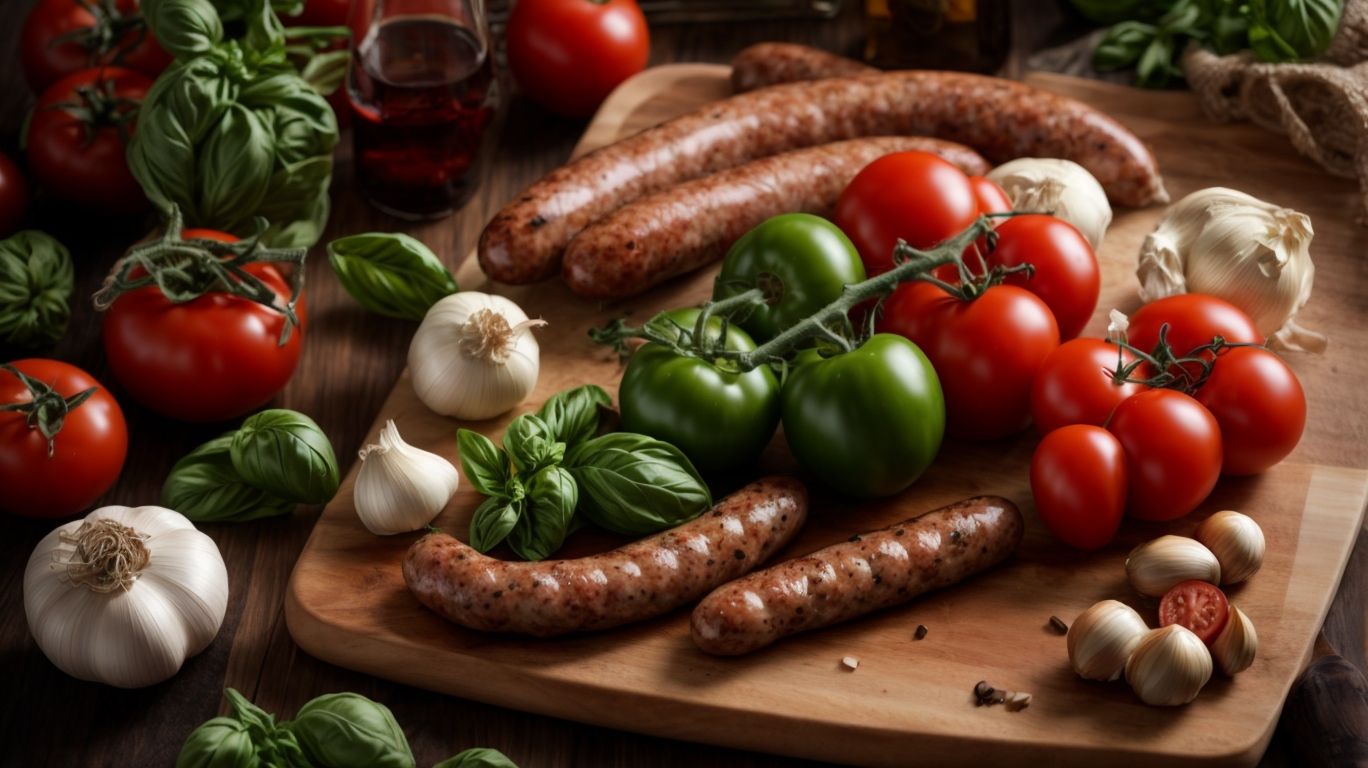How to Cook With Italian Sausage?
Italian sausage is a versatile and flavorful ingredient that can elevate any dish.
We explore the different types of Italian sausage, what sets it apart from other sausages, and how to choose the best one for your recipes.
Discover how to tell if Italian sausage is fresh, how to store it properly, and various cooking methods such as grilling, baking, sautéing, boiling, and broiling.
Find delicious recipes using Italian sausage and get helpful tips and tricks for cooking with this tasty ingredient. Whether you’re a seasoned chef or a cooking novice, master the art of cooking with Italian sausage.
Key Takeaways:
What is Italian Sausage?
Italian Sausage is a flavorful and versatile ingredient used in various cuisines, known for its blend of spices and savory taste.
Originating from Italy, this sausage is typically made with a mix of ground pork seasoned with fennel seeds, garlic, paprika, and various other herbs and spices that give it its distinct taste profile. The texture of Italian Sausage can range from coarse to fine, depending on the region and style of preparation. Whether it’s mild or spicy, this sausage is valued for adding depth of flavor to dishes such as pasta, pizza, soups, and sandwiches. The versatility of Italian Sausage allows it to be grilled, sautéed, baked, or crumbled into sauces.
Types of Italian Sausage
Italian Sausage comes in different varieties such as sweet, spicy, mild, and hot, each offering distinct flavors and levels of heat.
For those who enjoy a kick of heat, spicy Italian sausage is a popular choice. This type typically contains a blend of crushed red pepper flakes, paprika, and other spices to give it that fiery flavor.
On the other hand, sweet Italian sausage is characterized by its subtle, savory taste, often seasoned with fennel seeds that impart a unique aroma.
Mild Italian sausage strikes a balance between sweet and spicy, appealing to those who prefer a more mellow flavor profile.
Hot Italian sausage packs a powerful punch of spiciness, making it perfect for those who like their sausage with a bold kick.
What Makes Italian Sausage Different?
What sets Italian Sausage apart is its signature blend of seasonings, including garlic, fennel, and chili spices, creating a unique and robust flavor profile.
Garlic adds a distinct pungent sweetness to the sausage, while fennel seeds offer a subtle licorice-like flavor that permeates throughout each bite. The addition of chili spices brings a kick of heat that balances the other herbs and spices, resulting in a harmonious symphony of taste.
This combination of ingredients, carefully balanced to achieve the perfect blend of flavors, is what makes Italian Sausage a standout choice for culinary dishes. Whether grilled, sautéed, or added to sauces, the bold and savory profile of Italian Sausage never fails to delight the taste buds.
How to Choose the Best Italian Sausage?
Selecting the finest Italian Sausage involves considering factors like freshness, spice level, and quality of ingredients to ensure a delicious culinary experience.
Regarding freshness, opt for sausages that have a vibrant color and a clean, meaty smell. Check for any expiration dates and prefer sausages from reputable sources for guaranteed freshness.
In terms of spice level, ensure the sausage offers a satisfying kick without overpowering other flavors. The quality of ingredients is crucial; look for ground Italian Sausage made from premium cuts of meat combined with a blend of herbs and spices to enhance the taste profile.
What to Look for in Italian Sausage?
When selecting Italian Sausage, pay attention to key indicators such as the fat content, seasoning mix, and absence of preservatives for an authentic taste.
Italian Sausage is known for its distinct flavor profile, typically seasoned with a blend of fennel, garlic, and other herbs and spices.
Consider the seasoning variety carefully – whether you prefer a mild or spicy kick can greatly impact your overall satisfaction with the sausage.
Opting for sausages with lower fat content can help to create a balance between flavor and healthiness.
Choose sausages that do not contain unnecessary additives or preservatives to ensure a purer taste and healthier option for your meals.
How to Tell if Italian Sausage is Fresh?
Fresh Italian Sausage exhibits vibrant color, a pleasant aroma, and firm texture, indicating its quality and ensuring optimal flavor in your dishes.
When selecting high-quality fresh Italian Sausage, look for meat that boasts a rich reddish hue, signaling a perfect blend of spices and seasonings. Dark marbling within the sausage is a promising sign of superior taste and tenderness, while avoiding any gray or dull coloring is crucial.
The distinct garlicky scent that wafts from fresh Italian Sausage is a key indicator of its freshness. This aroma should be inviting, robust, and accompanied by subtle undertones of fennel and other aromatic herbs.
The texture of premium Italian Sausage should feel dense and meaty, with a slight give when pressed. Avoid products that feel overly mushy or excessively greasy, as they could signal a lower quality product.
How to Store Italian Sausage?
Properly storing Italian Sausage involves refrigeration or freezing to maintain its freshness and flavor, ensuring it stays safe for consumption.
For refrigeration, wrap the ground Italian Sausage in airtight packaging, such as plastic wrap or resealable bags, to prevent air exposure and freezer burn. Store it in the coldest part of the fridge at or below 40°F (4°C) and use it within 1 to 2 days.
When opting for freezing, divide the sausage into portion-sized servings before packaging. Place these portions in freezer-safe containers, ensuring all excess air is removed. Label the containers with the date of freezing and consume within 1 to 2 months for optimal quality.
Remember to always practice good hygiene when handling and storing the sausage to prevent cross-contamination. Thaw frozen sausage in the refrigerator or using the defrost setting on the microwave to maintain its quality.
How to Cook Italian Sausage?
Cooking Italian Sausage can be done through various methods such as grilling, baking, sautéing, boiling, and broiling, each offering a unique texture and flavor to the dish.
Grilling Italian sausage over an open flame enhances its smoky flavor and creates those enticing grill marks that add visual appeal.
On the other hand, baking Italian sausage in the oven allows the flavors to meld together slowly, resulting in a juicy and tender bite.
Sautéing Italian sausage in a skillet with onions, garlic, and spinach infuses the dish with rich aromas and flavors.
Boiling Italian sausage can be a quick method for pre-cooking it before grilling or adding it to sauces.
Broiling Italian sausage gives it a lovely char and crisped exterior, perfect for pairing with a heavy cream sauce or hearty vegetables.
Grilling Italian Sausage
Grilling Italian Sausage imparts a delicious smoky flavor and caramelized exterior, enhancing its natural spices and creating a delightful charred texture.
To truly elevate the flavors of Italian Sausage, consider marinating the sausages in a mixture of olive oil, minced garlic, and a dash of fiery red pepper flakes before grilling. This not only infuses the sausage with additional depth of taste but also helps to prevent dryness during cooking.
The magic of grilling Italian Sausage lies in achieving that perfect balance between a crisp, charred outer layer and juicy, succulent insides. The subtle anise-like flavor of fennel seeds that run through the sausage comes alive when exposed to the flames, creating a harmonious blend of savory and slightly sweet notes.
Baking Italian Sausage
Baking Italian Sausage in a rich tomato sauce with olive oil and fennel infuses the dish with robust flavors and tenderizes the meat for a satisfying meal.
The combination of olive oil, fennel, and tomato sauce not only adds depth to the taste but also creates a delightful aroma that fills the kitchen as it bakes. The olive oil helps in sealing in the juices of the sausage, keeping it moist and succulent. The fennel, with its slightly sweet and licorice-like flavor, complements the savory notes of the sausage, enhancing the overall profile of the dish. Simmering the sausages slowly in the tomato sauce allows the flavors to meld together, resulting in a harmonious blend by the time it’s ready to be served.
Sautéing Italian Sausage
Sautéing Italian Sausage with spinach, shredded parmesan, and a drizzle of olive oil creates a delectable dish with a perfect blend of flavors and textures.
As the Italian sausage sizzles in the pan, releasing its savory aroma, the spinach wilts gently, adding a fresh, earthy note to the dish. The subtle saltiness of the shredded Parmesan melts into the mix, enhancing the richness of the sausage. Drizzled with olive oil, each ingredient harmonizes in a symphony of taste.
The vibrant green of the spinach, the golden hues of the sausage, and the creamy white of the Parmesan come together not just in a culinary sense, but also visually, creating a feast for both the eyes and taste buds.
Boiling Italian Sausage
Boiling Italian Sausage with penne pasta, red pepper flakes, and a creamy sauce delivers a satisfying and quick meal that bursts with flavor and comfort.
Start by cooking the Italian sausage in a large skillet, breaking it up into bite-sized pieces as it browns. Once the sausage is cooked through, sprinkle in a pinch of red pepper flakes to add a hint of heat to the dish.
Next, pour in heavy cream and let it simmer gently, allowing the flavors to meld together. Meanwhile, cook the penne pasta in a separate pot until al dente, then drain and add it to the sausage and cream sauce.
Stir everything together until the pasta is well-coated in the creamy sauce, adjusting the seasoning if needed. Serve hot and garnish with freshly grated parmesan cheese for an extra touch of richness.
Broiling Italian Sausage
Broiling Italian Sausage coated with garlic, olive oil, and Parmesan Sauce yields a crispy exterior and juicy interior, offering a delightful contrast of textures and flavors.
The process of broiling ensures that the sausage retains its succulence while the high heat creates a caramelized crust on the outside, enhancing the overall taste profile. The garlic infuses the sausage with a fragrant aroma and a subtle garlic flavor, complemented by the richness of the olive oil.
As the sausage cooks, the Parmesan Sauce forms a golden, cheesy crust that adds a savory umami kick to each bite. The interplay of these ingredients results in a dish that is both comforting and satisfying, perfect for a quick and flavorful meal.
Recipes Using Italian Sausage

Credits: Poormet.Com – George Roberts
Explore a variety of delectable recipes featuring Italian Sausage, such as Italian Sausage and Peppers, Italian Sausage and Pasta, and Italian Sausage and Vegetable Skillet, offering flavorful dining options.
Italian Sausage and Peppers is a classic dish that combines the savory taste of Italian sausage with the vibrant sweetness of bell peppers, creating a harmonious flavor profile that is both comforting and satisfying. This recipe is often served over a bed of fluffy rice or crusty bread, allowing the rich juices to mingle with the starch for a delightful meal.
For a heartier option, Italian Sausage and Pasta is a crowd-pleaser, blending al dente pasta with robust sausage, tangy tomato sauce, and aromatic spices. The dish is commonly garnished with freshly grated Parmesan cheese and a sprinkle of fresh basil for a burst of freshness.
If you seek a healthier alternative, consider trying Italian Sausage and Spinach Skillet, where the earthy notes of spinach complement the bold flavors of the sausage. This dish is a perfect balance of greens and protein, offering a nutritious yet indulgent dining experience.
Italian Sausage and Peppers
Italian Sausage and Peppers is a classic dish that combines savory sausage, sweet bell peppers, and aromatic spices, creating a colorful and flavorful meal.
Ground Italian Sausage forms the hearty base of this dish, infusing each bite with rich flavors.
The vibrant red, yellow, and green bell peppers add a beautiful pop of color and a sweet contrast to the savory sausage.
To enhance the dish further, fragrant garlic and onions are sautéed until golden brown, creating a tantalizing aroma that fills the kitchen.
Italian Sausage and Pasta
Italian Sausage and Pasta is a comforting and creamy dish featuring tender pasta, savory sausage, and a luscious sauce that promises a satisfying dining experience.
One key element in creating this indulgent dish is the use of Olive Oil which not only adds richness but also enhances the flavors of the sausage and pasta. The process begins by sautéing Italian sausage in a pan until it’s browned and caramelized, infusing the dish with a deep umami taste.
Next, a touch of garlic is added to the pan, releasing its aromatic essence and further elevating the overall flavor profile. The fragrance of garlic merging with the sizzle of sausage creates an irresistible scent that fills the kitchen.
Italian Sausage and Vegetable Skillet
Italian Sausage and Vegetable Skillet is a quick and easy meal option for busy weeknights, combining wholesome vegetables, flavorful sausage, and a hint of spinach for added nutrition.
This one-pan dish is perfect for those looking to whip up a satisfying meal without spending hours in the kitchen. With a medley of colorful veggies like bell peppers, zucchini, and cherry tomatoes, the skillet bursts with flavors and textures that complement the savory sausage.
What sets this recipe apart is the inclusion of spinach, a powerhouse of nutrients like iron, vitamins A and C, and antioxidants. The spinach not only adds a vibrant pop of green but also elevates the dish’s nutritional profile.
Whether you’re a beginner cook or a seasoned chef, this Italian Sausage and Vegetable Skillet is a versatile and delicious option that can easily be customized based on your preferences.
Italian Sausage and Bean Soup
Italian Sausage and Bean Soup is a savory and flavorful dish packed with protein-rich sausage, hearty beans, and aromatic herbs, offering a satisfying and delicious meal.
This hearty soup combines the bold flavors of Ground Italian Sausage with the creamy texture of beans, creating a culinary masterpiece perfect for chilly evenings. The rich broth infused with garlic, onions, and Italian seasoning will transport you straight to the heart of Italy. Each spoonful is a comforting blend of tender sausage bites and tender beans, providing a protein-packed punch that will leave you feeling satisfied and content. The warmth and depth of flavors make this soup a go-to choice for a cozy dinner option that the whole family will enjoy.
Italian Sausage and Egg Breakfast Casserole
Italian Sausage and Egg Breakfast Casserole is a delightful morning dish that combines flavorful sausage, fluffy eggs, and a medley of breakfast ingredients for a satisfying start to the day.
In this simple yet delicious recipe, the rich flavors of Ground Italian Sausage are complemented by the creamy texture of eggs, creating a dish that is both hearty and comforting. The beauty of this casserole lies in its versatility; you can customize it with your favorite vegetables, cheeses, and herbs to suit your taste preferences. Whether you are hosting a brunch or simply looking for a nutritious and filling meal to kick off your day, this Italian Sausage and Egg Breakfast Casserole is sure to impress.
Tips and Tricks for Cooking with Italian Sausage

Credits: Poormet.Com – Thomas Sanchez
Enhance your culinary skills with expert tips for cooking with Italian Sausage, ensuring flavorful and delightful meals every time.
Ground Italian Sausage is a versatile ingredient that can elevate a wide range of dishes, from pasta to sandwiches and soups to pizzas. When cooking with Italian Sausage, consider using a mix of sweet and spicy varieties for a balanced flavor profile. To enhance the taste further, try incorporating aromatic herbs like basil, oregano, and fennel seeds. Experiment with different cooking methods such as grilling, sautéing, or simmering to bring out the unique flavors of the sausage. Remember to adjust the seasoning carefully as Italian Sausage is already rich in flavors.
How to Remove Casing from Italian Sausage?
Removing the casing from Italian Sausage is a simple process that involves gently slicing the casing lengthwise and peeling it off to access the seasoned meat inside.
Ensure your Ground Italian Sausage is placed on a clean, dry surface.
- Next, use a sharp knife to make a shallow cut along the entire length of the sausage, ensuring not to pierce the meat underneath.
- Once the incision is made, gently pull apart the casing halves, peeling them away from the meat.
- Proceed cautiously to avoid breaking the casing, and continue until the entire casing is removed, revealing the flavorful sausage meat ready for cooking or shaping into patties and meatballs.
How to Prevent Italian Sausage from Bursting?
Preventing Italian Sausage from bursting during cooking can be achieved by pricking the sausage with a fork or scoring the casing slightly, allowing steam to escape and maintaining its shape and flavor.
Another effective method is to ensure the sausage is cooked slowly over medium heat, preventing rapid expansion that can lead to bursting. By adding a small amount of water or broth to the pan, you can create steam that helps cook the sausage evenly without losing its juiciness. It’s also essential to avoid overcrowding the cooking pan, allowing space for the sausages to cook evenly. Preheating the pan before adding the sausages can help them cook more uniformly, further enhancing flavor retention and minimizing the risk of bursting.
How to Add Flavor to Italian Sausage?
Infusing additional flavor into Italian Sausage can be achieved by incorporating herbs, spices, and aromatic ingredients like garlic, fennel, and red pepper flakes, enhancing its savory profile.
One delightful way to enhance the flavor of Italian Sausage is to create a homemade seasoning mix using a blend of oregano, rosemary, and thyme. This aromatic trio not only adds depth to the sausage but also infuses it with a Mediterranean charm. To take it up a notch, consider adding a touch of fennel seed for that classic Italian sausage taste.
For those who enjoy a bit of heat, incorporating paprika and crushed red pepper flakes can bring a fiery kick to the sausage. The combination of these spices adds a smoky undertone and a lingering heat that complements the rich flavors of the meat.
How to Use Italian Sausage in Different Cuisines?
Italian Sausage is a versatile ingredient that can be incorporated into various cuisines, offering a fusion of flavors and culinary experiences in dishes like Italian Sausage Quesadillas or Baked Mostaccioli.
One of the unique qualities of Italian Sausage is its ability to infuse a dish with robust and savory flavors, making it a popular choice in global fusion recipes. For instance, in Asian-inspired stir-fries, the rich spices of Italian Sausage can beautifully complement the vibrant flavors of vegetables like bell peppers and snap peas.
In Mediterranean cuisine, Italian Sausage adds a depth of flavor to dishes like Spinach and Sausage Stuffed Mushrooms, where the earthy freshness of spinach pairs harmoniously with the seasoned meat.
Frequently Asked Questions
How to Cook With Italian Sausage?
Italian sausage is a versatile ingredient that can add flavor and protein to a variety of dishes. Here are six frequently asked questions on how to cook with Italian sausage.
What is the best way to cook Italian sausage?
The best way to cook Italian sausage depends on the dish you are making. Sausage can be grilled, pan-fried, baked, or added to soups or sauces. It’s important to cook the sausage fully to an internal temperature of 165 degrees Fahrenheit.
Can I cook Italian sausage without a grill?
Absolutely! You can cook Italian sausage in a pan on the stove, in the oven, or even in a slow cooker. Just make sure to adjust the cooking time and method accordingly to ensure the sausage is fully cooked.
Should I remove the casing before cooking?
It’s a personal preference, as the casing can add extra flavor and texture to the dish. However, if you prefer a smoother texture, you can remove the casing before cooking. Simply use a knife to cut along the length of the sausage and peel off the casing.
Can I use Italian sausage in pasta dishes?
Absolutely! Italian sausage is a popular addition to pasta dishes and can add a lot of flavor. You can either cook the sausage separately and add it to the pasta, or cook it with the pasta sauce for extra flavor.
What are some other ways to use Italian sausage?
Italian sausage is not just limited to pasta dishes. It can also be added to sandwiches, pizzas, soups, stews, and even casseroles. Get creative and experiment with different recipes to find your favorite way to use Italian sausage.
Are there any vegetarian options for Italian sausage?
Yes, there are now several vegetarian and vegan options for Italian sausage on the market. These are made with plant-based ingredients but still offer the same flavors and textures as traditional Italian sausage. Look for them in your local grocery store or make your own at home.






